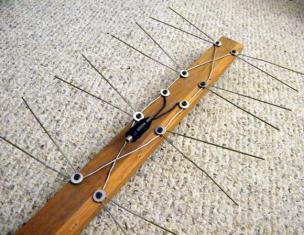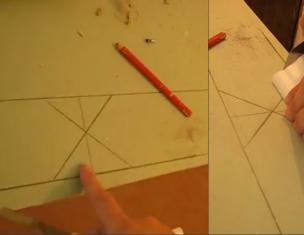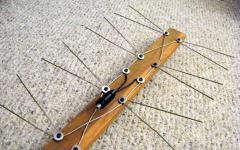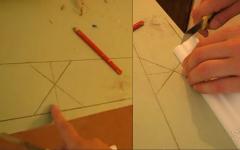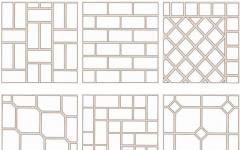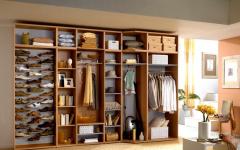In the choice of substrate thickness, it is necessary to focus on the condition and quality of the draft floor. 2mm thick substrate is permissible to use only if the floor has a good condition. For concrete with small flaws, it is worth choosing a substrate with a thickness of 3mm type isoplat.
Polyeneetylene substrates
Polyeneetylene substrates have gained their popularity due to high moisture resistance and good thermal insulatory properties. The coating is not of interest for rodents, insects and fungi. Manufacturers of polyethylene substrates expanded their range by combining a layer with a metallized aluminum-based film.
Cork substrates
The use of this type of substrate under the laminate is relevant in the case of laying floating gender and warm floors. Good insulation qualities, naturalness of material and resistance to mold and microorganisms made cork material by the leader in this segment.
We are produced in the form of sheets and rolls, convenient when laying on small areas. During the operational period, does not lose its technical properties and linear dimensions. The disadvantages of the material can be considered the likelihood of condensate on the underside of the laminate and the high cost.
Bitumen-cork substrates
Kraft paper, bitumen and cork crumb - components of bitumen-cork films. Cork sprinkle is performed from pieces of 2-3mm in size, which allows the coating at the proper level to provide air exchange and prevent condensation. Such a substrate is advisable to use when laying expensive laminate.
Polystyrene foam substrates
Extruded expanded polystyrene is used as the main material for the substrate due to the ability to well align the irregularities of a concrete base. Polystyrene foam is the best insulation for laminated floor. The closed structure of the cells of the material and the density provides high moisture resistance.
Combined substrates
The category of combined substrates includes the "duet" of polystyrene foam and polyethylene. Between two layers of polyethylene are located the smallest balls of polystyrene foam. High pressure polyethylene, forms the upper layer, prevents the penetration of moisture, which may be on the floor surface. Moisture from the draft base to the granular layer passes the thin bottom layer, then due to the technological gaps it is displayed outward.
The substrate is a special insulating material. It is used in order not to be direct contact laminate With a rough base of the floor. It is also necessary in order to provide additional sound insulation and moisture protection.
Instruction
Polyeomethenylene substrates are very popular. Among their positive qualities should be noted high moisture resistance and good thermal insulation. Also, the substrate is not infected with different bacteria and fungi. It is indifferent to rodents and insects. With such a type of substrate it is easy to work. They are economical, and also practically do not give waste. The material may have an additional layer of protective metallized film. Also used to protect the aluminum foil. Such a substrate is widespread due to its low cost.
However, polyethylene substrates in the presence of positive qualities, there are also negative. The fact is that the foamed substrate prevents its shape quite poorly. Over time, sediment occurs. Also, this material is very afraid of UV radiation.
Sometimes people are used cork substrates. They can be purchased in the construction market. For sale such substrates in sheets and rolls. It is this rigid insulating material best suited as a base under the floating floor. It is worth noting, this type of substrate has excellent thermal insulation qualities. Cork substrate is not subjected to rotting and mold. A significant disadvantage is that the formation of condensate on the underside of the flooring is possible.
you can use substrate From kraft paper, in which there is a bitumen. This substrate is covered with a crumb that promotes good ventilation. The bitumen layer does not allow moisture to penetrate. In addition, rubber-cork substrate You can call an excellent soundproofer. However, the cork substrate has a rather high cost. It is inappropriate to apply for an inexpensive laminated coating, with a slight service life.
Video on the topic
note
The appointment of the substrate under the laminate is to prevent the laminate and black floor contact, provide additional sound and thermal insulation, protect the laminate from moisture. At the moment there are models of laminate (32-33 classes) with an already integrated substrate. This option is quite convenient for the consumer. But what to do if the substrate must be selected and purchased independently?
Helpful advice
Substrate for laminate. Laminate has now gained great distribution in construction, as a relatively durable, wear-resistant and relatively cheap flooring. Advantages: Environmental, does not contain chlorine, freon, poorly pressed under load, has high wear resistance. Now about how the thickness of the substrate is better to choose. The fact is that many mistakenly believe that a thick substrate will better compensate for the unevenness of the floor.
When choosing a substrate for laminate, it is primarily necessary to pay attention to the properties of the material, such as moisture resistance and thermal conductivity. Depending on the type of premises, the substrate requirements are different, in addition, not all materials are durable, therefore it is worth navigating on the estimated deadlines for the laminate operation.

Why do you need a substrate?
It is recommended to lay panels so that they are located along the direction of the sun's rays. There are two ways to fix laminate: Collapsible and castle-latch. Each of them has its own features of the installation. The assembly of panels with the castles of the first type starts from measuring the width of the room and determining the number of cloth laminate in one row. If the residual value exceeds 5 cm, it is necessary to cut the first and last panel so that they are the same in width. In the calculations, it is necessary to take into account the gap by the walls, which should be at least 8 mm. In order to accurately withstand this distance, the wedges of the corresponding thickness are installed along the plinth.
Laminate laying starts from the left corner of the room and are gradually moving towards the corner of the opposite wall. To the first panel brings the second and install it at an angle of 30to. Then it is inserted into the groove of the already laid canvase and snap, "softly" clutching to the floor. In the case of a "latch" type lock, both panels must be near each other. The spike one is inserted into the groove of the other, after which the canvas are bridged to each other with rubber Cyans.



